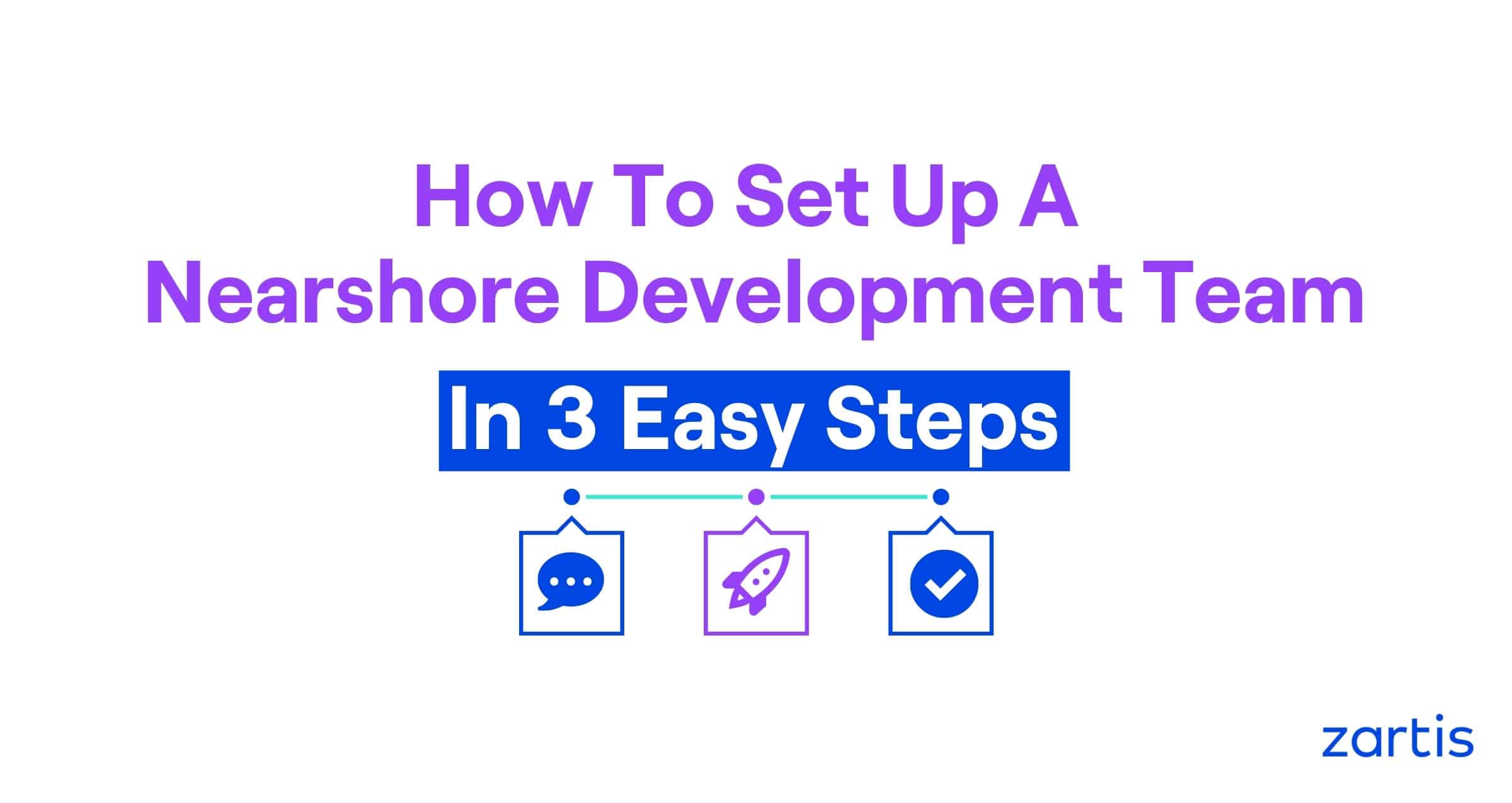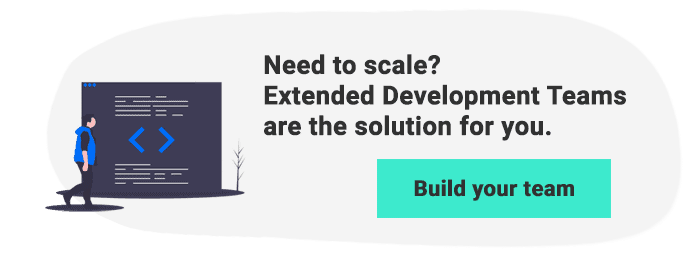#Nearshoring
Setting up an extended software development team can be a sure-fire way to overcome the difficulty of hiring software engineers locally. We’ve helped companies in Ireland, the UK and the United States among others, build an extended software development team in Europe using the Nearshore Development model.
What is Nearshore Software Development?
Traditionally, ‘nearshoring’ has meant a company sub-contracting part of its work to an external company, usually operating in the same time zone, in a country with similar financial and legal systems.
At Zartis, we believe it’s time to widen the nearshore definition.
‘Nearshore Development’ for us means extended IT teams working in a more integrated, cohesive way, without sacrificing corporate culture or approach to work. It means creating an extension of your team with cultural similarities that just happens to be in another geographic location.
Nearshore Outsourcing vs. Offshore Outsourcing
We say “nearshore outsourcing” because it is the most proven, cost-effective method to create an extension of your software development team. Unlike offshore outsourcing, nearshore teams benefit from close proximity or sharing similar time zones (8 hours or less) with their parent companies. Synchronization of ideas and faster communication all lead to a swifter software development for a lower cost.
Think ‘offshore project outsourcing’, and you probably think India or Ukraine. And as a short-term solution, IT outsourcing to teams in India, China or Ukraine can be effective – particularly for large companies fully outsourcing specific projects without the need to integrate with their team; eliminating the language barrier and clash of different work ethics.
But for work that requires deep knowledge, greater innovation, or a specific skill set–such as cloud architecture expertise–the experience is often less satisfactory. The Deloitte survey found that, although companies increasingly expect innovation as part of their outsourcing arrangement, they “still struggle to define, track, and motivate innovation from their service providers”.
And for smaller companies, for whom a cohesive culture, optimum communication between teams, and a unified approach to projects is important, working with an outsourcing company in a distant location is simply too great a risk. The same goes for some of the outsourcing companies in Eastern Europe, where cultural differences are too wide or “smooth communication” is not always a given.
We asked our team member, Michal, who is a principal software engineer working out of our extended development center in Poland: What is the most challenging aspect of working in a distributed team? How do you overcome this challenge?
His Answer: For me, this is without a doubt the communication & dissemination of information. You want your team members to be able to ask questions and get answers as easily as if they could get up and ask a colleague at another desk. We are also your full time employees and if we feel integrated, we will work harder for the success of your software product. This is not always possible if that colleague and that desk are thousands of kilometers apart! Something that I observed in good software companies is the use of and regular training on knowledge base systems, public and outspoken communication of changes and a nurtured public and digital forum where everybody is allowed to ask questions and answer others.
As you can see, all roads leading to a successful project pass through good communication. This becomes much harder if you picked an IT outsourcing partner works on a completely different time zone or different methodologies. Check out the full interview here!
Benefits of Nearshore Software Development
Nearshore outsourcing can reduce your cost base, but it isn’t just about reducing costs. Primarily, it’s about accessing a wider pool of tech talent, without compromising on:
- quality software
- the quality of the developers in your remote team
- cultural fit
- your ability to manage the team and the software project
- your approach to risk and security in the development process
- the value you put on things like innovation and quality assurance
A financially driven reason for outsourcing is that it can turn fixed costs into variable costs. While you can delegate your software development to a service provider locally, hiring a foreign contractor is usually more cost-effective. For more information on the advantages of having a nearshore team, check out our article: 5 Benefits of Having an Extended Development Team
Nearshoring Software Development with Zartis:
Step 1: Getting to know you and your software project
The first step is to understand your company and business goals. We want to know what makes your company one of the best – what’s great about your culture and the technology you’re building. Maybe it’s the fact that you build custom software that impacts people’s lives or you give your software engineers the time and space to work on special interest projects.
Regarding the software engineering project you need help with – what is the tech stack you’re using and are there gaps in the technical expertise of the team we should complement with remote development?
In addition, we need to understand your goals and expectations – where do you expect your product development to be in 1 year or in 5? Do you need to up your web development game or do you need better mobile applications?
All of this will help us tailor the best solution for your needs and be the development partner that answers your needs at a wider scale. Choosing an outsourcing partner is a decision that will affect your business objectives on the long term, just like it would ours. Therefore, we want to make sure we are the right nearshoring partners for each other before we set sail.
Step 2: Nearshore solution design & deployment
We design the best software development path for you – this includes the technological expertise we’re looking for, team size and structure, team location – office requirements vs a fully distributed team. This is our extended teams as a service model, so you get to define the requirements and deliverables.
When we are both confident that we’re set up for success, we’ll work with you to map out what the software development process will look like.
We set up a recruitment process customized to your needs – from the technical test to the technical interviews. Our senior engineers and CTO conduct all interviews with the European talent pool. We check software developers not only for coding skills but also for cultural fit as well as their grip on modern software development practices such as; agile software development methodologies, DevOps, cloud savviness, microservices, PWAs, UX/UI, and more.
You only see the very best candidates who have passed the process and we would recommend hiring. We are your outsourcing partner, so you have the final say on who becomes yours and our new team members.
Step 3: Set up and ongoing management
We issue offers and manage contracts of employment. Our job is not done once contracts are signed, and the team is set up. We take care of the operational project management. We look after the office and equipment setup, security, payroll services; making sure that local health and safety legislation is adhered to; even that the coffee machine is working.
We make sure that all the headaches that usually arise from managing a remote office are taken care of. When you think about your extended team, we want you to be able to focus on technical productivity, instead having to pay a fine because there’s no fire extinguisher in the office. We take care of everything and send you a transparent single monthly invoice, so you can focus on what matters – building great software.
—
Zartis has deep expertise in large-scale software development and IT recruitment projects across different European locations, serving clients in the US, UK, Ireland, Germany, Denmark and Spain. We have software development centers in Spain, and Poland and we can help you build remote development teams from scratch.
We will offer you a personalized and cost-effective solution that:
- Minimizes risks
- Meets your business goals and development needs
- Cuts down on the admin, onboarding process, and the red tape
But most importantly, we will handpick the best engineers who will get the job done.
Next Steps
Want to learn more about nearshore and offshore software outsourcing before you decide? Do this:
- Check out our in-depth comparison between nearshore and offshore outsourcing.
- Read a real-life case study on outsourced software development.
- Find out what is the best country to outsource your software development.
- Be alert to situations where you may need an extended development team.
- Find out to Ins and Outs of choosing an outsourcing partner properly.
- Talk to Zartis to learn how we can assist your company on your outsourcing journey.



